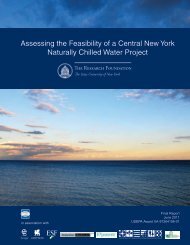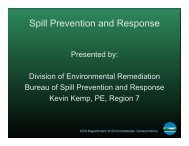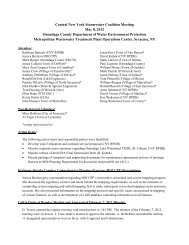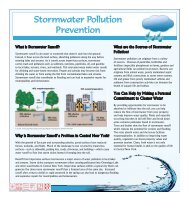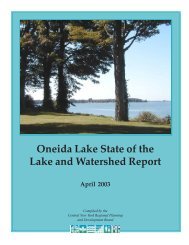A Management Strategy for Oneida Lake and its ... - CNY RPDB Home
A Management Strategy for Oneida Lake and its ... - CNY RPDB Home
A Management Strategy for Oneida Lake and its ... - CNY RPDB Home
You also want an ePaper? Increase the reach of your titles
YUMPU automatically turns print PDFs into web optimized ePapers that Google loves.
Preventing Septic Waste Runoff From<br />
On-Site Sewage Disposal Systems<br />
Program Goal<br />
Protect public health <strong>and</strong> prevent environmental degradation by reducing<br />
non-point source pollution to surface water <strong>and</strong> groundwater from septic waste<br />
throughout the <strong>Oneida</strong> <strong>Lake</strong> watershed<br />
Problem Identification<br />
The US Environmental Protection Agency<br />
(EPA) estimates that anywhere from 10 to 25<br />
percent of onsite systems are failing annually<br />
(Source:www.epa.gov/owm/mtb/decent/summ<br />
ary.htm). Poor site conditions contribute to the<br />
problem. Environmental constraints include<br />
limited soil permeability, seasonally high<br />
groundwater levels, limited topographic relief,<br />
<strong>and</strong> poor drainage. It has been estimated that<br />
only 32% of the total l<strong>and</strong> area in the United<br />
States has soils suitable <strong>for</strong> on-site systems<br />
that utilize the soil <strong>for</strong> final treatment <strong>and</strong><br />
disposal of wastewater (US EPA. 1980.<br />
Design Manual: Onsite Wastewater Treatment<br />
<strong>and</strong> Disposal Systems).<br />
Improper system installation <strong>and</strong> poor maintenance<br />
can cause system failure. Failure to<br />
upgrade the on-site septic system when a<br />
summer cottage is converted to a year round<br />
home can lead to problems. Full-time or high<br />
use of vacation homes served by systems<br />
installed under outdated practices or designed<br />
<strong>for</strong> part-time occupancy often results in poor<br />
water quality.<br />
Pumpout <strong>and</strong> disposal of wastewater from<br />
boats <strong>and</strong> marinas pose a non-point source<br />
pollution threat. Close proximity of individual<br />
septic systems to waterbodies <strong>and</strong> drinking<br />
water wells can also pose a threat to human<br />
health.<br />
A lack of adequate homeowner education<br />
needs to be addressed, as some residents are<br />
not aware <strong>and</strong>/or concerned about failing<br />
septic systems.<br />
Limited financial resources make it difficult<br />
<strong>for</strong> families to maintain or replace failing<br />
systems. Many homeowners with inadequate<br />
sewage disposal systems do not have the<br />
financial resources to make repairs <strong>and</strong>/or are<br />
not aware of state <strong>and</strong> federal funding assistance<br />
opportunities.<br />
Some residential lot sizes are inadequate to<br />
support on-site septic systems. There is also<br />
an overall lack of en<strong>for</strong>cement due to limited<br />
staff <strong>and</strong> monetary resources.<br />
Impacts<br />
Failing septic systems release nutrients <strong>and</strong><br />
pathogens to the environment, subsequently<br />
posing human health problems <strong>and</strong> degrading<br />
the aesthetic values <strong>and</strong> recreational potential<br />
<strong>for</strong> <strong>Oneida</strong> <strong>Lake</strong> <strong>and</strong> <strong>its</strong> tributaries. Bacteria,<br />
parasites <strong>and</strong> viruses present in effluent can<br />
result in health problems <strong>for</strong> both humans <strong>and</strong><br />
animals. Septic systems sited too close to<br />
wells <strong>and</strong> ground water supplies can contaminate<br />
drinking water. Nitrogen <strong>and</strong> phosphorus<br />
from failing septic systems can enter the lake<br />
<strong>and</strong> tributaries <strong>and</strong> cause algae to proliferate<br />
<strong>and</strong> reach dense populations, causing a bloom<br />
to occur. When the bloom dies off, dissolved<br />
oxygen levels can be severely depleted <strong>and</strong> the<br />
amount of oxygen available to fish <strong>and</strong> other<br />
Chapter 3: Priority Areas page 49




